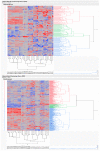Dissecting Source-Sink Relationship of Subtending Leaf for Yield and Fiber Quality Attributes in Upland Cotton (Gossypium hirsutum L.)
- PMID: 34199872
- PMCID: PMC8229918
- DOI: 10.3390/plants10061147
Dissecting Source-Sink Relationship of Subtending Leaf for Yield and Fiber Quality Attributes in Upland Cotton (Gossypium hirsutum L.)
Abstract
Photosynthesis as a source is a significant contributor to the reproductive sink affecting cotton yield and fiber quality. Moreover, carbon assimilation from subtending leaves adds up a significant proportion to the reproductive sink. Therefore, this study aimed to address the source-sink relationship of boll subtending leaf with fiber quality and yield related traits in upland cotton. A core collection of 355 upland cotton accessions was subjected to subtending leaf removal treatment effects across 2 years. The analysis of variance suggested a significant effect range in the source-sink relationship under subtending leaf removal effects at different growth stages. Further insight into the variation was provided by the correlation analysis and principal component analysis. A significant positive correlation between different traits was observed and the multivariate analysis including hierarchical clustering and principal component analysis (PCA) categorised germplasm accessions into three groups on the basis of four subtending leaf removal treatment effects across 2 years. A set of genotypes with the lowest and highest treatment effects has been identified. Selected accessions and the outcome of the current study may provide a basis for a further study to explore the molecular mechanism of source-sink relationship of boll subtending leaf and utilization of breeding programs focused on cotton improvement.
Keywords: cotton boll; multivariate analysis; source-sink relationship; subtending leaf; upland cotton.
Conflict of interest statement
The authors declare no conflict of interest. The funders had no role in the design of the study; in the collection, analyses, or interpretation of data; in the writing of the manuscript, or in the decision to publish the results.
Figures






Similar articles
-
Photosynthetic characteristics of the subtending leaf of cotton boll at different fruiting branch nodes and their relationships with lint yield and fiber quality.Front Plant Sci. 2015 Sep 17;6:747. doi: 10.3389/fpls.2015.00747. eCollection 2015. Front Plant Sci. 2015. PMID: 26442060 Free PMC article.
-
Carbohydrate metabolism in the subtending leaf cross-acclimates to waterlogging and elevated temperature stress and influences boll biomass in cotton (Gossypium hirsutum).Physiol Plant. 2017 Nov;161(3):339-354. doi: 10.1111/ppl.12592. Epub 2017 Jul 14. Physiol Plant. 2017. PMID: 28581029
-
Boll-leaf system gas exchange and its application in the analysis of cotton photosynthetic function.Photosynth Res. 2021 Dec;150(1-3):251-262. doi: 10.1007/s11120-021-00856-w. Epub 2021 Jun 24. Photosynth Res. 2021. PMID: 34165685
-
Fiber Quality Improvement in Upland Cotton (Gossypium hirsutum L.): Quantitative Trait Loci Mapping and Marker Assisted Selection Application.Front Plant Sci. 2019 Dec 11;10:1585. doi: 10.3389/fpls.2019.01585. eCollection 2019. Front Plant Sci. 2019. PMID: 31921240 Free PMC article. Review.
-
Genetics and Breeding for Glandless Upland Cotton With Improved Yield Potential and Disease Resistance: A Review.Front Plant Sci. 2021 Oct 6;12:753426. doi: 10.3389/fpls.2021.753426. eCollection 2021. Front Plant Sci. 2021. PMID: 34691130 Free PMC article. Review.
Cited by
-
Intensifying heat stress impacts cotton flowering and boll development efficiency.BMC Plant Biol. 2025 Jul 30;25(1):984. doi: 10.1186/s12870-025-06934-8. BMC Plant Biol. 2025. PMID: 40739483 Free PMC article.
-
Activation of Gossypium hirsutum ACS6 Facilitates Fiber Development by Improving Sucrose Metabolism and Transport.Plants (Basel). 2023 Oct 11;12(20):3530. doi: 10.3390/plants12203530. Plants (Basel). 2023. PMID: 37895992 Free PMC article.
-
Unraveling Heat Tolerance in Upland Cotton (Gossypium hirsutum L.) Using Univariate and Multivariate Analysis.Front Plant Sci. 2022 Jan 13;12:727835. doi: 10.3389/fpls.2021.727835. eCollection 2021. Front Plant Sci. 2022. PMID: 35095940 Free PMC article.
-
Improved cotton yield: Can we achieve this goal by regulating the coordination of source and sink?Front Plant Sci. 2023 Mar 29;14:1136636. doi: 10.3389/fpls.2023.1136636. eCollection 2023. Front Plant Sci. 2023. PMID: 37063185 Free PMC article. Review.
-
Estimating the combining ability and genetic parameters for growth habit, yield, and fiber quality traits in some Egyptian cotton crosses.BMC Plant Biol. 2023 Mar 2;23(1):121. doi: 10.1186/s12870-023-04131-z. BMC Plant Biol. 2023. PMID: 36859186 Free PMC article.
References
-
- Zhang X., Kong X., Zhou R., Zhang Z., Zhang J., Wang L., Wang Q. Harnessing perennial and indeterminant growth habits for ratoon cotton (Gossypium spp.) cropping. Ecosyst. Health Sustain. 2020;6:1715264. doi: 10.1080/20964129.2020.1715264. - DOI
-
- Oerke E.C. Crop losses to pests. J. Agric. Sci. 2005;144:31–43. doi: 10.1017/S0021859605005708. - DOI
-
- Veres A., Wyckhuys K.A., Kiss J., Tóth F., Burgio G., Pons X., Avilla C., Vidal S., Razinger J., Bazok R. An update of the Worldwide Integrated Assessment (WIA) on systemic pesticides. Part 4: Alternatives in major cropping systems. Environ. Sci. Pollut. Res. 2020;27:29867–29899. doi: 10.1007/s11356-020-09279-x. - DOI - PMC - PubMed
Grants and funding
LinkOut - more resources
Full Text Sources

